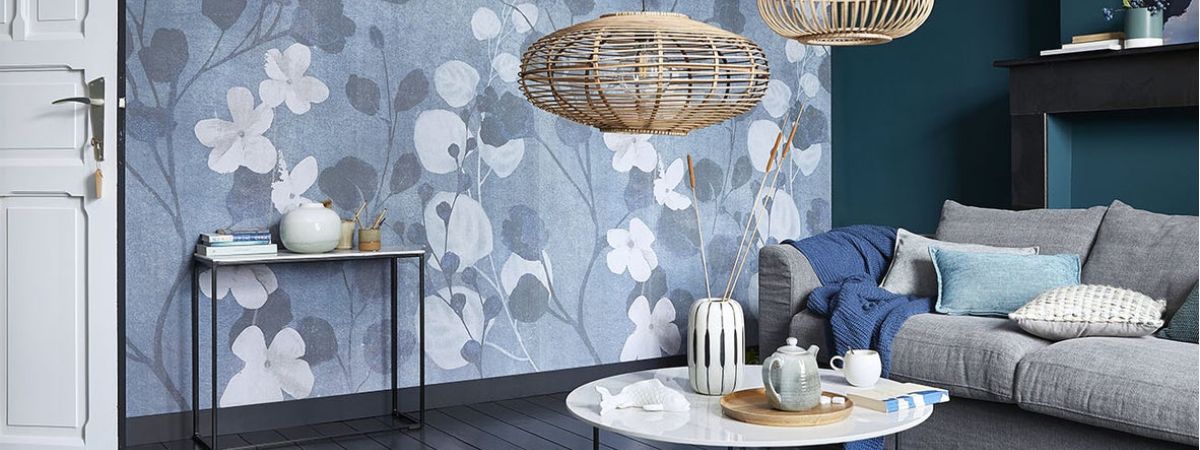
Do you know the Ikigai? This method from Japan, which offers everyone to find their life mission, gave their name to a decorative trend. There are obviously Japanese inspirations but above all the purity and materials of the nature style. If you like minimalist but sensual interiors, conducive to peace of mind and rejuvenation, if you like shades of blue and light wood, if you like elegance that knows how not to overdo it, you will love the Ikigai trend.
Ikigai Style: A Palette Of Blues
As on a Japanese print which infinitely declines the nuances of water, the Ikigai trend invites the whole palette of aquatic blues. From celadon to blue India ink, the color settles in all its forms: in surfaces, in accents, in small touches. For the rest of the room, we calm the game with neutral shades like white and beige. The atmosphere is Zen and peaceful while having real originality. Contrasts are then mastered.

Plant And Graphics Patterns

Plant motifs are in the spotlight and in particular the water lily or lotus leaves, emblematic of Japanese art. In bluish hues, they give rhythm to a rather refined decoration.
It is a good way to personalize your decor by covering only a section of the wall. We get here the perfect balance dear to the Ikigai trend, Japanese but not cold or even empty.
An idea to adopt in the bedroom: use a panoramic patterned wallpaper as a headboard. The pattern structures and gives an orientation to the room without overloading the space.
Wallpaper with its spectacular plant motifs is also a good way to liven up a room without overloading the space, as the Ikigai balance wants.
A Refined Lifestyle Like In Japan

Much more than a decoration, Ikigai is a philosophy. It is translated by “raison d’être” or sometimes “mission of life“. The Ikigai arises for each of us from a synthesis between different personal elements such as our talents or our passions.
In decoration, the Ikigai trend also brings together concepts that are not always easy to mix, such as serenity and sensuality. How? ‘Or’ What? Thanks to a clever balance between the purity of the compositions and the sensoriality of the materials.
As in Japan, we like rooms where space is free, where the gaze circulates, but where each object has a story, an extra soul. It’s up to you to store the essentials in discreet cupboards so that only a few skillfully arranged objects are left in view.
Textiles With Natural Fibers And Reliefs
In an interior with refined decor, we like to add softness and sensuality. With Ikigai, this mission comes down to textiles. We choose natural fibers such as cotton, linen, mesh.
We prefer when we can see the textures, those that make you want to touch the fabric. So choose the irregular mesh from the weaving, very authentic. Think about it for your cushions, plaids, carpets or curtains.
Luminaires Made Of Natural Materials
With the Ikigai trend, paper lights gain in grace and refinement, like semi-transparent sculptures.
Another option for luminaires in an Ikigai interior: natural fiber luminaires, which also play with light and transparency. You can use them as a table lamp in a bedroom or living room but also in suspension. And for an even more unexpected effect, you can attach suspensions of different sizes.
Do you know the Japanese paper folding technique? Origami makes it possible to create real paper sculptures, both light and deeply elegant, perfectly suited to the Ikigai trend. Diverted into the decor, paper origami can become a plain shade or with a plant motif. In the ceramic version, it keeps its elegant geometric forms to become a tealight for example or a vase. Paper, light, durable and decorative, is a staple of Ikigai decoration.
Light Wood Accessories And Natural Materials

Ikigai’s palette of colors between blue and white is warmed up by natural materials . For furniture, light wood asserts its naturalness and sensuality.
Headboard, coffee table in the living room or bathroom furniture, blond wood breaks cold colors. We prefer it worked in simple and timeless lines , both authentic and very contemporary.
The natural fibers accompany it in harmony for the lights but also the carpets, the baskets or even in the form of bouquets of grasses.